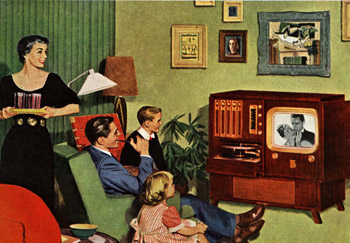The Rise and Fall of the TV Commercial
ADText: Advertising Curriculum
Unit 21: The Rise and Fall of the TV Commercial

1. Introduction—A Salesman in Every Living Room
Following the end of World War II, television began a meteoric rise from an obscure and expensive technology available in only a few large American cities to become the ascendant mass medium within a few short years. By the early 1950s, a television set was a regular furnishing in most American living rooms, and the uninvited salesmen who came along had a new platform for pitching every manner of goods and services.
Television offered advertisers new techniques to promote their products. Moving, visual imagery accompanied by complex soundtracks replaced the frozen words and images of the printed page and the voice, sounds, and music of radio ads. In other words, all of what had preceded television—the face-to-face salesmanship of the 19th century, the printed advertisements of late 19th and early 20th century, and radio jingles and pitches of the 20s, 30s, and 40s—were merged in this new form. It could do any—or all—of the things that had been possible in the previous media. Only some advertisers rushed headlong to embrace the new medium in the early stages of its development, but the others quickly learned that failure to jump on the bandwagon would mean commercial suicide.






